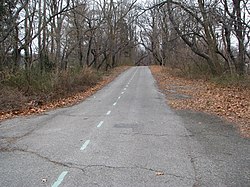Long Island Motor Parkway
|
Long Island Motor Parkway
|
|

Remnant of Long Island Motor Parkway c. 2008 at Springfield Boulevard in Queens, looking East
|
|
| Location | Roughly Alley Pond and Cunningham Parks, between Winchester Blvd. and Clearview Expressway, between 73rd Ave. and Peck Ave., Queens, New York City, New York |
|---|---|
| Coordinates | 40°44′13″N 73°45′35″W / 40.73694°N 73.75972°W |
| Area | 10 acres (4.0 ha) |
| Built | 1908 |
| Architect | Williams, E.G.; Brown, E.H. |
| NRHP Reference # | 02000301 |
| Added to NRHP | April 01, 2002 |
| County Route 67 | |
|---|---|
| Location: | Huntington–Lake Ronkonkoma |
| Length: | 14.51 mi (23.35 km) |
The Long Island Motor Parkway (LIMP), also known as the Vanderbilt Parkway and Motor Parkway, was a parkway on Long Island, New York, in the United States. It was the first roadway designed for automobile use only. The road was privately built by William Kissam Vanderbilt II with overpasses and bridges to remove intersections. It opened in 1908 as a toll road and closed in 1938 when it was taken over by the state of New York in lieu of back taxes. Parts of the parkway survive today in sections of other roadways and as a bicycle trail in Queens.
William Kissam Vanderbilt II, the great-grandson of Cornelius Vanderbilt, was an auto-racing enthusiast and created the Vanderbilt Cup, the first major road racing competition, in 1904. He ran the races on local roads in Nassau County during the first decade of the 20th century, but the deaths of two spectators and injury to many others showed the need to eliminate racing on residential streets. Vanderbilt responded by floating a company to build a graded, banked and grade-separated highway suitable for racing that was also free of the horse manure dust often churned up by motor cars. The resulting Long Island Motor Parkway, with its banked turns, guard rails, reinforced concrete tarmac, and controlled access, was the first limited-access roadway in the world.
The road was originally planned to stretch for 70 miles (110 km) in and out of New York City as far as Riverhead, the county seat of Suffolk County, and point of division for the north and south forks of Long Island. Only 45 miles (72 km) (from Queens in New York City to Lake Ronkonkoma) were constructed, at a cost of $6 million. Construction began in June 1908 (a year after the Bronx River Parkway). On October 10, 1908, a 10-mile-long (16 km) section opened as far as modern Bethpage, making it the first superhighway. It hosted races in 1908 and on the full road in 1909 and 1910, but an accident in the latter year's Vanderbilt Cup, killing two riding mechanics with additional injuries, caused the New York Legislature to ban racing except on race tracks, ending its career as a racing road.
...
Wikipedia


